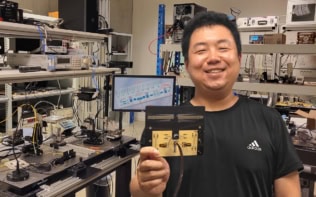
The optoelectronic properties of topological insulators have many attractions, including a robustness to defects, imperfections and sharp corners. This robustness inspired a group of scientists to design and demonstrate the feasibility of a topological insulator laser. The resulting laser is reported to preserve single-mode lasing even at very high gains.
While the first discovered topological insulators were electronic, nowadays scientists have developed them in many other physical systems, including photonic, mechanical, acoustic and cold atoms. In all these systems, topological insulators are defined by the transport properties, in that the bulk is insulating but the surface or edge states are conducting.
In topological insulator lasers, light can move around the cavity of any shape without scattering or disorder. It also propagates in a unidirectional fashion, unaffected by the shape of the edges. This robustness to defects, fabrication imperfections and sharp edges gives topologically protected states an advantage over conventional cavity modes for lasing.
The theory
Efficient lasers that are more immune to operational disorder and defects may be possible by exploiting topological properties, as a group of scientists from Israel, Singapore and the USA, led by Mordechai Segev from Technion, Israel and Mercedeh Khajavikan and Demetrios Christodoulides from CREOL at UCF, Florida, demonstrate both theoretically and experimentally in two recently published papers.
For the theoretical analysis, the group simulated several planar arrays of active coupled ring resonators, including the Haldane toy model – a honeycomb ring of micro-resonators. An output coupler collects the light from the cavity and verifies the working conditions of the structure. In fact, the Haldane model exhibits two distinct phases: a trivial phase and a topological one, which can be controlled by tuning the coupling between the resonators. In the topological phase the edge states, existing around the conductive edges of the structure, appear and propagate around the cavity. This, however, is not the case for the trivial phase, in which the lasing mode localizes and never reaches the output coupler. Light reaching the output coupler therefore signifies that topologically protected states are lasing in the cavity.
Segev and colleagues then introduced disorder and defects into their cavities (such as a missing resonator along the edge of the cavity) and verified that the edge mode remained unaffected. However, for the trivial-phase cavity, the presence of either disorder or defects reduces its already weak external coupling.
In practice
For the experimental realization, the CREOL-Technion collaboration fabricated two 10×10 arrays of microresonators on an active platform of 30 nm thick InGaAsP quantum wells, one of them being topological and the other trivial. They interrogated the edge states by pumping the structure under various conditions and measured the light at the output coupler. Independently of the pumping structure (i.e. which micro-resonators were excited), the edge states in the topological lattice example always travelled around the structure reaching the output coupler. The trivial structure differed in that the modes localize and cannot make it to the output.
Details are available in two recently published papers covering both the theory and experiment.



